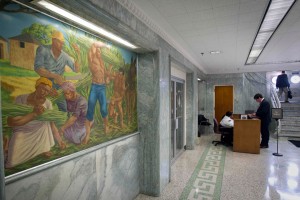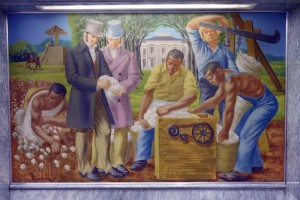 The incoming Georgia agriculture commissioner plans to remove seven murals by George Beattie from the lobby of the Department of Agriculture in Atlanta across from the state Capitol.
The incoming Georgia agriculture commissioner plans to remove seven murals by George Beattie from the lobby of the Department of Agriculture in Atlanta across from the state Capitol.
Beattie’s paintings were commissioned in 1956 and depict the history of agriculture in the state, from half-naked Native Americans cultivating corn to a state farmers market to a 20th-century veterinary lab. Somewhere in between there are two idealized depictions of slavery, one of strapping slaves harvesting sugar cane, the other of equally strapping slaves picking cotton and using a cotton gin to separate seed from fiber under the dignified eye of a pair of white overseers.
Conservative Republican Commisioner-elect Gary Black finds them “undesirable” and plans to take them out of the lobby and put them in storage. The unobjectionable state farmers market one might remain in use, but not in the lobby.
“I don’t like those pictures,” said Republican Gary Black, the newly elected agriculture commissioner. “There are a lot of other people who don’t like them.” […]
“I think we can depict a better picture of agriculture,” Black said.
There are no signs of the whippings, beatings, shackles or brutality used to subjugate the slaves, who appear healthy, muscular, even robust.
 Beattie’s son George Beattie III says his father thought slavery was terrible but that he was asked to depict the history of agriculture in Georgia, and that means depicting slaves who were 40% of the state’s agricultural workers by 1840. Historical accuracy did not demand that he depict them in the blazing good health of a ruddy Soviet farmer on a propaganda poster, though.
Beattie’s son George Beattie III says his father thought slavery was terrible but that he was asked to depict the history of agriculture in Georgia, and that means depicting slaves who were 40% of the state’s agricultural workers by 1840. Historical accuracy did not demand that he depict them in the blazing good health of a ruddy Soviet farmer on a propaganda poster, though.
Even Beattie’s close friend, sculptor and professor emeritus at Georgia State University George Beasley, who believes the paintings should remain where they are, admits that the painter had a penchant for idealized, shiny-happy images, which puts the lie to the notion that the paintings are only about presenting Georgia history as it was.
The year those paintings were hung, after all, was a landmark year in Georgia’s racist history. It’s the year a Confederate Battle Flag was added to the state flag in protest of school desegregation. Governor Marvin Griffin declared that “the schools are not going to be mixed come hell or high water.” The Confederate flag remained on the state flag until Governor Roy Barnes replaced it in 2001, a decision that may have played a pivotal role in his failure to secure re-election the next year.
Gary Black is the first new agricultural commissioner in 41 years. Outgoing commissioner Tommy Irvin was appointed by segregationist governor Lester Maddox in 1969 and ran undefeated, often unopposed, for the next 10 elections. If Irvin hadn’t decided to retire this year, Black might have lost yet again, just like he did in 2006. He has all kinds of reasons for wanting a fresh start.